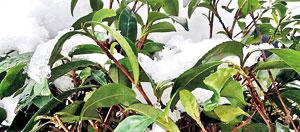New Scottish blend; no not whisky but tea

Camellia sinensis sinensis (that can deal with -15°C) thriving in Scotland
“This will make your body active and lusty!”
It was the first time I had filled my mouth with antlers. Tentatively, but with more curiosity than trepidation, I pushed my lips forward.
“It was grown by a Church of Scotland minister on Mull. ” It sounded a terrible deformity.
Our tea tasting session was taking place in Amrulee , ninety minutes north of Ediburgh.
“It should invigorate your soul,” smiled my Scottish tea-tutor, pouring a cup of “Scottish Antlers”. It is made by the Rev Liz Gibson on her croft on the isle of Mull, off Scotland’s west coast. It is not made from antlers. It’s just a catchy title to help keep spreading the brews.
Tea is thought to have been discovered by Chinese Emperor Sheng Nung 5000 years ago when some leaves fell in a cup of water. But the world’s youngest commercial tea plantations are now in Scotland where tea is being grown from Orkney to Dumfries and Galloway to the Hebrides and a former sheep farm in Perth and Kinross.
My tea-tutor, agricultural chemist Tam O’Brann founded “The Wee Tea Company” in 2011 in Amrulee. His Dalreoch state ( Gaelic for “Field of Kings”) now has 14000 tea plants. He also founded the “Scottish Tea Growers’ Association. It has eleven members.O’Brann hopes for 30.
“Our stated aim has always been to grow an industry. Not something quirky. Not an oddity. But something serious. To be respected, like Scottish whisky.
“Growing tea in Scotland has the potential of being an industry. We are building the country’s first tea processing factory. It will be solar powered. But based on the methods I unearthed in a book about the early Sri Lanka tea days.”
O’Brann and the tea growers of the Lowlands, Highlands and islands are hoping to bring a new drink industry to the boil. But it is not a new idea.
During the Second World War there were plans to plant tea in Scotland. O’Brann was inspired by the nineteenth century Scottish botanist , plant hunter and probable spy, Robert Fortune, who brought tea from China to India. Scots planted most of Darjeeling’s tea estates.

Tam O’Brann
The UK’s first plantation was Tregothnan in Cornwall which opened in 1999.
“The Wee Tea Company” sells 15g tins of “Camellia sinensis” for £35, Scottish tea is not a low-grade teabag tea. It has won awards at Paris’s Salon de The and is available at London’s Fortnum & Mason and Dorchester Hotel where Tam has planted a rooftop tea garden.
He claims the Scottish climate is an advantage. Due to slower growth the leaves develop a better flavour profile and a greater depth of flavour.
He poured me out some artisanal blend “Highland Chai”. And continued to pour forth. “You don’t need heat to grow tea. The original teas were grown in the Himalayan foothills in temperatures as low as -15°C. Using an Italian variety we propagate from seed, gro-wn in an unheated greenhouse, planted out after eighteen months and picked at four years. The harvest starts in February.”
My tea-torial continued with what was my first “First Flush”, some of the house white tea. Then came some bee-balm scented single estate Garracher Grey from Newton Stewart near Dumfries. This was followed by a recipe for tea loaf and Highland Chai brulee. The finale was “The Wee Tea Co’s signature cuppa,“Rosy Black”.
Affecting the anti-oxidant connoisseur with the hypersensitive and educated palate, I discreetly consulted my tasting notes. They told me to expect deep malty , biscuit flavours with a hint of a floral finish. “A complex yet delicate tea with layers of surprise.” I was not surprised to learn that loose tea is benefitting from flagging teabag sales. O’Brann believes location is critical. “Although our Association members won’t be producing commercial quality tea until 2018 we are capable of producing different tastes from different places. Just like the distilleries.”


